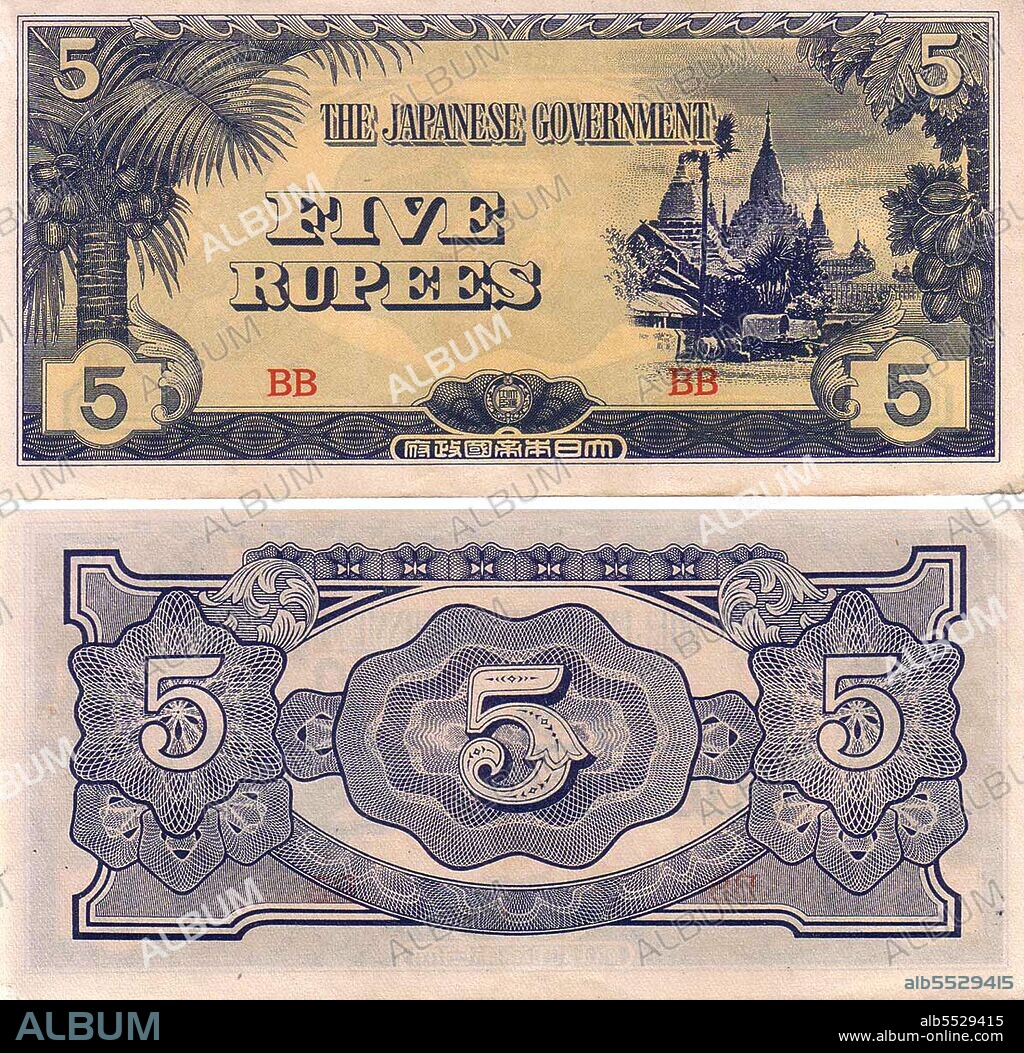alb5529415
Burma / Myanmar: Japanese World War II occupation money. Five Rupee note issued c. 1942. National Numismatic Collection, National Museum of American History (CC BY-SA 4.0 License).

|
Añadir a otro lightbox |
|
Añadir a otro lightbox |



¿Ya tienes cuenta? Iniciar sesión
¿No tienes cuenta? Regístrate
Compra esta imagen.
Selecciona el uso:

Título:
Burma / Myanmar: Japanese World War II occupation money. Five Rupee note issued c. 1942. National Numismatic Collection, National Museum of American History (CC BY-SA 4.0 License).
Descripción:
Traducción automática: Birmania, un importante campo de batalla, fue devastada durante la Segunda Guerra Mundial. En marzo de 1942, pocos meses después de entrar en la guerra, las tropas japonesas habían avanzado hacia Rangún y la administración británica había colapsado. Los japoneses establecieron una administración ejecutiva birmana encabezada por Ba Maw en agosto de 1942. Los Chindits británicos de Wingate se formaron en grupos de penetración de largo alcance entrenados para operar muy detrás de las líneas japonesas. Una unidad estadounidense similar, los Merodeadores de Merrill, siguió a los chindits hasta la jungla birmana en 1943. A finales de 1944, las tropas aliadas lanzaron una serie de ofensivas que condujeron al fin del dominio japonés en julio de 1945. Sin embargo, las batallas fueron intensas con mucho de Birmania arrasada por los combates. En total, los japoneses perdieron unos 150.000 hombres en Birmania. Aunque muchos birmanos lucharon inicialmente para los japoneses, algunos birmanos, en su mayoría pertenecientes a minorías étnicas, también sirvieron en el ejército británico de Birmania. El Ejército Nacional de Birmania y el Ejército Nacional de Arakan lucharon con los japoneses de 1942 a 1944, pero cambiaron su lealtad al bando aliado en 1945.
A major battleground, Burma was devastated during World War II. By March 1942, within months after they entered the war, Japanese troops had advanced on Rangoon and the British administration had collapsed. A Burmese Executive Administration headed by Ba Maw was established by the Japanese in August 1942. Wingate's British Chindits were formed into long-range penetration groups trained to operate deep behind Japanese lines. A similar American unit, Merrill's Marauders, followed the Chindits into the Burmese jungle in 1943. Beginning in late 1944, allied troops launched a series of offensives that led to the end of Japanese rule in July 1945. However, the battles were intense with much of Burma laid waste by the fighting. Overall, the Japanese lost some 150,000 men in Burma. Although many Burmese fought initially for the Japanese, some Burmese, mostly from the ethnic minorities, also served in the British Burma Army. The Burma National Army and the Arakan National Army fought with the Japanese from 1942 to 1944, but switched allegiance to the Allied side in 1945.
Crédito:
Album / Pictures from History/Universal Images Group
Autorizaciones:
Modelo: No - Propiedad: No
¿Preguntas relacionadas con los derechos?
¿Preguntas relacionadas con los derechos?
Tamaño imagen:
4176 x 4078 px | 48.7 MB
Tamaño impresión:
35.4 x 34.5 cm | 13.9 x 13.6 in (300 dpi)
Palabras clave:
ASIA • ASIATICO • BILLETES • BIRMANIA • CHINA • CHINO • CONFLICTO BELICO • DINERO • EEUU / ESTADOS UNIDOS • ESTADOS UNIDOS • GRAN BRETAÑA • GUERRA MUNDIAL II 1939/45 • GUERRA • HISTORIA • HISTORICO • INDIA • INGLATERRA • JAPON • JAPONES • KAI-SHEK, CHIANG • MILITAR • MYANMAR • NUMISMATICA • REINO UNIDO • SEGUNDA GUERRA MUNDIAL 1939/45 • SEGUNDA GUERRA MUNDIAL • WAR
 Pinterest
Pinterest Twitter
Twitter Facebook
Facebook Copiar enlace
Copiar enlace Email
Email
